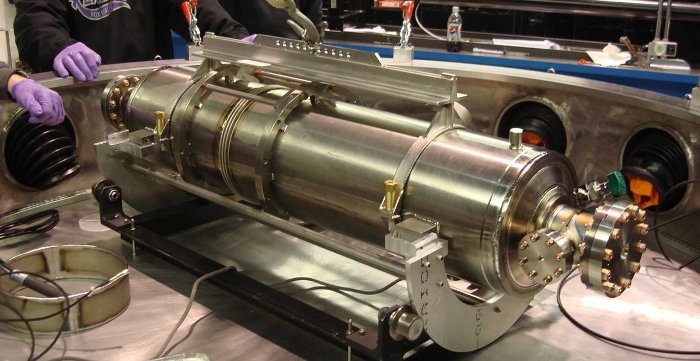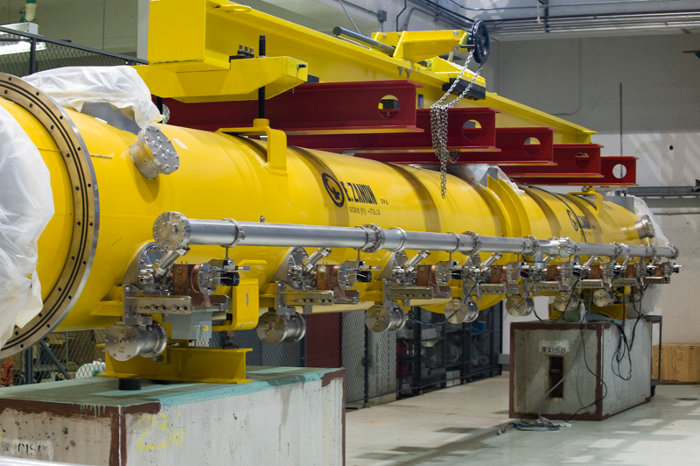Director's Corner
20 August 2009
 Barry Barish |
Stimulus funds for SCRF at Fermilab
Today's column is jointly authored by Bob Kephart, Fermilab ILC Program Director, and Barry Barish, GDE Director
Five years ago today, the International Technology Review Committee (ITRP) made their recommendation that the design of the International Linear Collider (ILC) should be based on superconducting RF technology (SCRF). A very important consideration in that decision was that SCRF is a forward-looking technology that will have broad applications to future accelerators, whether for research, industry or medicine. The announcement by the U.S. Department of Energy that it will provide $52.7M of American Recovery and Reinvestment Act (ARRA) funds to develop the Fermilab (SCRF) programme is a very welcome development. This decision fits very well with the philosophy that recovery funding should provide both short-term economic stimulus and enhance future economic growth through improving technical infrastructure and capability.
We emphasise that the SCRF recovery act funds to Fermilab are not specifically for the ILC R&D programme, but rather are more generally to develop SCRF capabilities in the US. Nevertheless, the ILC will be a beneficiary of this investment, as will other possible future accelerator applications, like the proposed Project X at Fermilab and possibly other future longer-range projects like a muon collider.
The focus of the ILC SCRF R&D programme is more focused specifically towards developing high gradient cavities and performing crucial operational demonstrations of our design. To build or help build the next generation of SCRF particle accelerators a country must also develop the necessary technical know-how, advanced infrastructure and industrial capability.
The Recovery Act funds in the US will support the development of US industrial capability, where about 80 percent of the ARRA funds will be invested. The new funds will advance US-built SCRF components and industrialisation by two to three years. Faster US procurements of accelerating cavities and cryomodules will allow US industry to develop the capabilities they need to become competitive manufacturers of SCRF components. The US programme is centered at Fermilab, but a portion of the funds will also be used to upgrade existing infrastructures at Argonne National Laboratory, Thomas Jefferson National Accelerator Facility, and at SLAC National Accelerator Laboratory. Collectively, this national laboratory infrastructure will allow the US to better prototype, construct, and support SCRF-based accelerators.
The priorities of the US programme are to master the SCRF technology at Fermilab and elsewhere, build the required infrastructure to prepare for future projects, and develop the needed industrial base. In addition to work already supported by annual DOE funding, the ARRA funding will support:
- the construction of the New Muon Lab RF unit test facility, including a building addition, a new large 1.8-K refrigerator, new injector and beam line components, and provisions for future stand-alone cryomodule test stands
- cryogenic upgrades and additional vertical test systems to increase bare cavity test capacity to 240 tests per year. When combined with JLAB testing capabilities, this will enable the construction of Project X cryomodules over four years
- purchase of new industrial high-temperature vacuum oven optimised for 800 degrees Celsius hydrogen degassing of high purity niobium cavities
- development of qualified US industrial vendors for nine-cell cavities via construction of about 40 nine-cell cavities by two or more US cavity vendors
- development of qualified industrial vendors for cryomodule parts including parts for two complete cryomodule cold masses
- development of cavity electropolishing facilities with increased capacity and performance in collaboration with ANL and JLab
- development of qualified US industrial vendors for nine-cell cavity electropolishing including bulk electropolishing of a number of nine-cell cavities. Combined with upgraded electropolishing, high-pressure rinse, ultra-clean water, and clean room facilities at ANL and JLab this will produce sufficient capacity to fabricate the one cryomodule per month needed for Project X during construction
- R&D in collaboration with industry and university partners to develop future cavity surface treatments that are more environmentally friendly than the current hydrofluoric-acid-based electropolishing technique
- RF power components for a new horizontal test system capable of simultaneously testing two nine-cell cavities
- development of qualified US industrial RF power source components including one 10-MW klystron and high-power RF couplers.
 Dressed US-made Advanced Energy Systems (AES) cavity Dressed US-made Advanced Energy Systems (AES) cavity |
 Overview of the New Muon Laboratory (NML) at Fermilab Overview of the New Muon Laboratory (NML) at Fermilab |
ARRA funds will support construction of the infrastructure necessary to start Project X in 2013 to 2014 or would allow participation in the ILC later in the decade. By about 2012 Fermilab will have assembled and tested four cryomodules similar to those needed for Project X or ILC. Two of these cryomodules will be constructed of components fabricated in US industry. Fermilab, JLab, and ANL will have developed the infrastructure to collaboratively process and test cavities at the rate required for Project X.
Construction of the New Muon Laboratory (NML) RF unit test facility including the buildings, a new large 1.8-K refrigerator, injector, and beam lines will enable testing of complete RF units of cryomodules for Project X or ILC under realistic beam conditions, RF power, and repetition rates. Completion of the new buildings near NML will allow space for future stand-alone cryomodule test stands.
In summary, ARRA funding will enable a timely start of Project X, allowing US scientists a variety of opportunities at the intensity frontier and enabling many decades of quality scientific research. It will also serve to position the US for participation in the ILC or Muon Collider later in the decade. ARRA funding will advance industrial SCRF capabilities by more than three years and promises to greatly enhance the US SCRF capabilities, preparing it to play a central role in the key technology for the next generation of accelerators. For the ILC, this investment will strengthen both our short-term R&D programme, but even more importantly, it will significantly increase the global capability to undertake such an ambitious project.
-- Barry Barish, Bob Kephart

